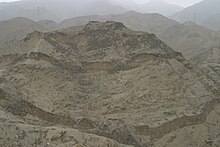Acaray: Difference between revisions
m →References: Hans instead of H |
added photo |
||
| Line 1: | Line 1: | ||
[[Image:Vista a Sector B 8-10-04.JPG|thumb|Fortified hilltop at Acaray]] |
|||
'''Acaray''', also known as the '''Fortress of Acaray''', is an [[archaeological site]] located in the [[Huaura River]] Valley on the near north coast of [[Peru]] (or the [[Norte Chico (Peruvian region)|Norte Chico]]). The impressive [[fortress]] is located on a series of three hilltops, each ringed with a number of perimeter defensive walls that have [[parapet]]s and [[bastions]], which stand as testaments to the military nature of the site. Surrounding the hilltop fortress are lower-lying areas of occupation and extensive cemeteries that have been heavily looted. |
'''Acaray''', also known as the '''Fortress of Acaray''', is an [[archaeological site]] located in the [[Huaura River]] Valley on the near north coast of [[Peru]] (or the [[Norte Chico (Peruvian region)|Norte Chico]]). The impressive [[fortress]] is located on a series of three hilltops, each ringed with a number of perimeter defensive walls that have [[parapet]]s and [[bastions]], which stand as testaments to the military nature of the site. Surrounding the hilltop fortress are lower-lying areas of occupation and extensive cemeteries that have been heavily looted. |
||
Revision as of 00:42, 14 October 2007

Acaray, also known as the Fortress of Acaray, is an archaeological site located in the Huaura River Valley on the near north coast of Peru (or the Norte Chico). The impressive fortress is located on a series of three hilltops, each ringed with a number of perimeter defensive walls that have parapets and bastions, which stand as testaments to the military nature of the site. Surrounding the hilltop fortress are lower-lying areas of occupation and extensive cemeteries that have been heavily looted.
History of Research
Attention was called to the site early on by the German archaeologist Hans Horkheimer, who wrote about Acaray in 1962 in the Peruvian magazine, Caretas, published in Lima. Calling it the Fortaleza de Huaura (the Fortress of Huaura), he deemed Acaray to be a true fortress, unlike the more well-known neighboring site of Paramonga in the Pativilca River Valley, whose defensive nature has been questioned. Horkheimer noted the abundance of rolled river cobbles on the surface of the site which were likely used as projectiles or slingstones[1].
During the 1970s interest in Acaray increased and the first work by archaeologists was initiated at the fortress. Peruvian archaeologist Mercédes Cárdenas, of the Riva Agüero Institute, excavated at Acaray, among other coastal sites, as part of a larger project to understand the use of marine resources in the past on the Peruvian coast and to obtain radiocarbon dates. She led a team that surveyed the Huaura Valley and excavated at several sites, including the hilltop fort at Acaray [2]. Around the same time, Peruvian archaeologist Arturo Ruiz Estrada, of the National University José Faustino Sánchez Carrión, and Peruvian engineer Domingo Torero visited the fortress and wrote a detailed account describing the architectural features of the siteCite error: The <ref> tag has too many names (see the help page)..
In 2004, North American archaeologist Margaret Brown Vega, of the University of Illinois at Urbana-Champaign, began research at Acaray, carrying out intensive mapping, surface analysis, and excavations, which lasted for two years.
